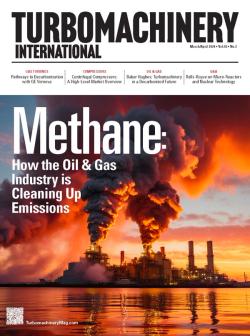
OR WAIT null SECS
© 2024 MJH Life Sciences™ and Turbomachinery Magazine. All rights reserved.
MYTH: GAS TURBINE BLADES ARE VULNERABLE
Many people who operate or otherwise work with gas turbines (GTs) are in awe about the extraordinarily harsh environment in which compressor and turbine blades operate. Yet these blades prove to be incredibly sturdy and reliable.
Just to put things in perspective: A single turbine blade, only a few inches in height and width, mounted in a 30,000 hp GT produces about 500 hp of power. It achieves that while operating at a pressure that’s the equivalent to being 700 ft underwater at the temperature of hot molten lava while running at speeds of more than 10,000 rpm. And we expect these blades to survive this ordeal for tens of thousands of operating hours.
Design trial and error methods are a thing of the past. Combining computational fluid dynamics and heat transfer calculations allows for the precise determination of local blade pressures and temperatures.
From this, stress levels, vibration modes and vibration frequencies can be predicted precisely. Moreover, it is sometimes possible to measure the blade temperatures, or blade vibrations and stresses in the running engines.
New and exciting methods have been developed to accomplish this, like measuring blade surface temperatures with irradiated silicon carbide crystals, or non-intrusive stress measurement systems that use laser sensors to determine blade vibration behavior in an operating development engine.
Real-time modal response of the rotor is evaluated using laser sensors, and the stress level is measured for each blade in situ. Modern engineering analysis and design methods have undoubtedly improved the reliability and availability of the internal parts of the GT.
Yet turbine and compressor blades do sometimes fail and are destroyed: The failure modes and mechanics are often related to constituents in the fuel or the combustion air that can damage the engine. The most important ones are:
• Corrosion is the wearing away of surface metals due to a chemical reaction of the metal with the environment
• Oxidation is the chemical reaction between a component and the oxygen in its surrounding gaseous environment. The oxidation rate increases with temperature
• Hot corrosion, also called high-temperature corrosion, requires the interaction of the metal surface with another chemical substance at elevated temperatures. It is a form of accelerated oxidation that is produced by the chemical reaction between a component and molten salts deposited on its surface.
The molten salts can form if sulfur and sodium or potassium participate in the combustion process. Sulfur, sodium and potassium can enter the engine via the fuel or combustion air. It is important to recognize that corrosion processes are sometimes self-propagating and can continue even if the source is removed or abated.
Consequently, GT materials need to be protected from the harsh service atmosphere by special material selection and coatings. Advanced high-nickel super alloys are used to make blades. Manufactures have successfully employed coatings in GTs to combat oxidation, corrosion, and erosion, and as thermal barriers.
Some coatings and pre-coated parts can even be added during routine maintenance, if economically and technically warranted. The use of coated parts, however, does not remove the requirement for good inlet air filtration.
Erosion usually requires relatively large particles, exceeding five microns in size, or liquid droplets to hit the blades, and is typically only a problem when the GT’s air filtration system is damaged or inadequate, or if poorly designed inlet cooling moisture fog systems create large droplets.
High-cycle fatigue can be another failure mode. It is often tied to other component problems, such as damaged variable vanes, combustor instabilities or clogged fuel injectors. The resulting flow non-uniformities create high, cyclic forces for the subsequent rotating blades.
Another cause can be undetected blade-wake interactions that excite natural blade frequencies. Modern design methods, as described above, can prevent the latter issues, while the former are usually the result of damage to other engine parts, which can be detected by appropriate condition monitoring systems.
Fundamentally, all metals have fatigue limits that are a direct function of the combination of applied cyclic and steady loads. Any mechanical high frequency, high-amplitude excitation source, such as unsteady aerodynamics, vibrations, and even thermal cycling, can result in metal fatigue failures in a GT.
The creep life of blades and disks is determined by the exposure to high-temperature gases. It is one of the critical limiting factors in the engine life cycle and is well understood in the design process of the engine.
However, exposure of components to temperatures higher than their design temperature will reduce the creep life of the component and may require premature engine overhauls.
Yes, it is a dangerous world for blades. Yet the reliability and availability of GTs have significantly increased over the years as failure mechanisms are better understood, prediction and test methods have improved, and conditions monitoring provides valuable indications to identify problems before they lead to failure.


